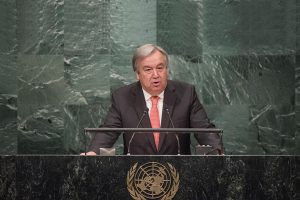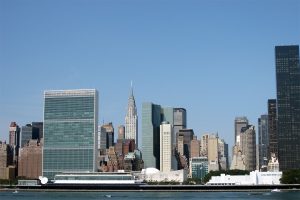We are in a planetary emergency: forests hold the key to preventing a climate breakdown, but decisive action is needed from governments and companies.
More than ever before, we now know how important forests are to stabilizing our climate and providing us with essential services such as clean water and medicines. We have more business commitments to protect forests than ever before. We have more public finance invested in halting deforestation and restoring forests than ever before. Yet, we are losing forests, like never before.
We have more public finance invested in halting deforestation and restoring forests than ever before. Yet, we are losing forests, like never before.
This month marks the fifth anniversary of the New York Declaration on Forests (NYDF), which brought together governments, companies, civil society and indigenous peoples in an effort to halve deforestation by 2020 and end it by 2030. The Sustainable Development Goals (SDGs), agreed by all UN Member States the following year, not only included a target to halt deforestation by 2020 but recognized the critical role forests play in helping achieve other goals. And all these efforts have been complemented with pledges by hundreds of major companies to make their supply chains deforestation and conversion free.
Instead, as 2020 approaches, deforestation is still rising. From Indonesia to the Amazon, we’re seeing forests go up in flames. These immense fires have released vast quantities of carbon dioxide into the atmosphere – and given us a terrifying glimpse of what a changing climate looks like – both as a cause and result of forest fires.
This is a planetary emergency. If we’re to avoid the catastrophic impacts of a climate breakdown, and achieve the SDGs, then protecting and restoring forests has to be at the top of the agenda of world leaders, civil society and businesses, who are gathering in New York this week for the UN General Assembly and Climate Summit.
Deforestation-free Supply Chains
The latest NYDF Progress Assessment shows that the current implementation of public and private sector commitments is failing to address the destruction of natural ecosystems. Companies must redouble their efforts to achieve deforestation- and conversion-free supply chains, while ensuring this doesn’t compromise food security and human rights. We now have an important tool in the form of the Accountability Framework, which can help companies track their supply chain efforts.
Public sector efforts are essential to complementing these efforts, and we are convening partners this week to discuss how this can be achieved. Governments in both producer and consumer countries need to provide an enabling environment, for example by reforming trade and agriculture policies, subsidies and investments that promote unsustainable production. They should support public-private partnerships and place-based initiatives to promote deforestation- and conversion-free agriculture. Collaboration on the jurisdictional level can also have positive impacts as part of a holistic approach.
We’ve seen welcome signals in recent months – from the French Government’s strategy on deforestation to a long awaited plan by the European Commission to address the EU’s impact on deforestation. We need now specific and measurable interventions urgently, and similar recognitions across the world, in both producing and consuming countries.
Climate Contributions
In parallel, governments need to show much greater ambition and recognition of the role of forests in their climate commitments.
It’s mathematically impossible to meet the goals of the Paris Agreement without addressing the land sector.
It’s mathematically impossible to meet the goals of the Paris Agreement without addressing the land sector. Nature-based solutions in the form of forests and other natural ecosystems are the most cost-effective carbon-capture technology available: ending deforestation, preserving forest carbon sinks and restoring forests has the potential to avoid nearly a third of global emissions. Yet countries’ nationally determined contributions (NDCs) don’t currently reflect the potential of forests to support national climate resilience and mitigation goals. While 77% of NDCs contain commitments for restoring forest landscapes, only 26% have quantifiable targets. The next round of NDCs need to include more ambitious, measurable commitments.
In post-2020 frameworks, we also need to address forest quality, not just quantity: as well as halting deforestation, we need to prevent further degradation of forest habitats. I come to New York also to share new WWF research that shows that forest wildlife populations have fallen by more than half since 1970, which has a direct impact on forests’ ability to regenerate and provide vital services. The NYDF Assessment 2019 shows us that while there is progress on forest landscape restoration, most of the gains have been outside forests. Restoring natural forests is critical to adequately maintaining the value of forests and to ensure we optimize their contribution to climate change mitigation.
A New Deal for Nature and People
This year’s UN General Assembly is the moment for world leaders to recognize the emergency facing our planet – because the decisions they make next year could determine our planet’s future. In 2020, governments will be agreeing on a new global biodiversity framework, new climate change action plans and renewed commitments under the Sustainable Development Goals.
We are in New York this week to call for a united effort – a New Deal for Nature and People – a fresh approach that recognizes the fundamental link between nature, climate and people, reaffirms ambitious conservation targets and sets new ones, and defines strengthened mechanisms to put them into practice. Because of their crucial importance for the climate, biodiversity and people, forests need to be front and centre of this New Deal. We need to see real action from businesses and governments towards the following:
- Halting the conversion of forests to agriculture by 2030 and other land uses and preventing a repeat of the fires of 2019;
- Restoring 350 million hectares of forest landscapes, and promoting healthy, carbon rich, natural forests alongside productive forests where needed; and
- Increasing the proportion of forests under protection or sustainable management – including putting more forests into the hands of indigenous peoples and local communities –to 50% by 2030; and promoting effective and inclusive management of protected forests.
We need to act now, before our best chance of averting a climate catastrophe goes up in smoke.
This article was authored by Will Baldwin-Cantello, Lead, WWF Global Forest Practice.


